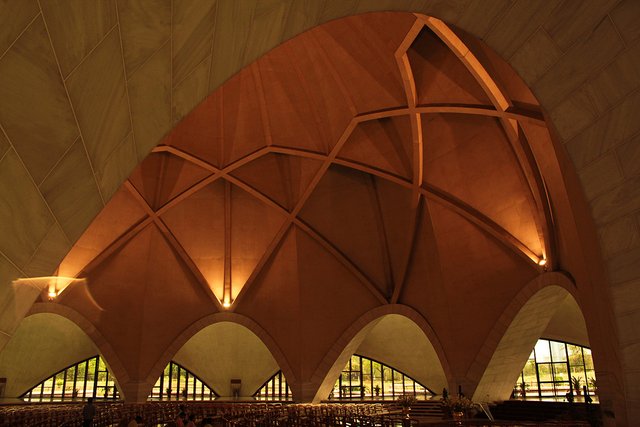A $10 million Temple OPEN TO ALL
The Lotus Temple, located in Delhi, India, is a Bahá'í House of Worship that was dedicated in December 1986, having been completed for a total cost $10 million. It serves as the Mother Temple of the Indian subcontinent. Notable for its flowerlike shape, it has become a prominent attraction in the city. Like all Bahá'í Houses of Worship, the Lotus Temple is open to all, regardless of religion or any other qualification. The building is composed of 27 free-standing marble-clad "petals" arranged in clusters of three to form nine sides, with nine doors opening onto a central hall with height of slightly over 40 metres and a capacity of 2,500 people. The Lotus Temple has won numerous architectural awards and been featured in hundreds of newspaper and magazine articles. A 2001 CNN report referred to it as the most visited building in the world.

WORSHIP
The Bahá'í Faith teaches that a Bahá'í House of Worship should be a space for people of all religions to gather, reflect, and worship. Anyone may enter the Lotus Temple irrespective of religious background, sex, or other distinctions, as is the case with all Bahá'í Houses of Worship. The sacred writings of not only the Bahá'í Faith but also other religions can be read and/or chanted, regardless of language; on the other hand, reading non-scriptural texts is forbidden, as are delivering sermons or lectures and fundraising. Musical renditions of readings and prayers can be sung by choirs but no musical instruments can be played inside. There is no set pattern for worship services, and ritualistic ceremonies are not permitted.
![Camera360_2014_9_3_113340_jpg.jpg]
 (
( )
)
The temple is in the village of Bahapur in New Delhi, National Capital Territory of Delhi. The architect was an Iranian, who now lives in Canada, named Fariborz Sahba.[12] He was approached in 1976 to design it and later oversaw its construction. The structural design was undertaken by the UK firm Flint and Neill over the course of 18 months,[5] and the construction was done by ECC Construction Group of Larsen & Toubro Limited.[13] The major part of the funds needed to buy this land was donated by Ardishír Rustampúr of Hyderabad, Sindh, who gave his entire life savings for this purpose in 1953.[14] A portion of the construction budget was saved and used to build a greenhouse to study indigenous plants and flowers that would be appropriate for use on the site.